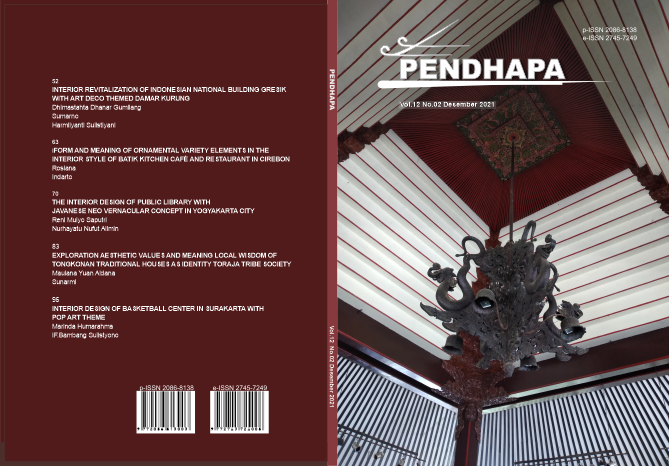The Interior Design of Public Library with Javanese Neo Vernacular Concept in Yogyakarta City
DOI:
https://doi.org/10.33153/pendhapa.v12i2.3500Keywords:
Interior Design, Public Library, Javanese Neo, Vernacular ConceptAbstract
The existence of quality and adequate reading facilities is one of the many factors that can encourage people's interest in reading. Based on research at various Taman Baca Masyarakat (TBM) in Yogyakarta, it proves that the existence of reading facilities has a positive impact, including increasing interest in reading, empowering the community, being independent in terms of the economy, and others. Yogyakarta as a City of Students and City of Culture has various educational facilities ranging from elementary to tertiary levels. A large number of educational facilities, in particular, has increased the need for libraries as a place to look for references and as an alternative source of knowledge other than formal schools. The study aims to produce an educational and recreational library with modern packaging that considers elements of culture, tradition and local wisdom as the embodiment of Javanese Neo Vernacular concepts. The creative process in this creation uses a functional approach, an ergonomic approach, and a theme approach. The design implementation is translated through the Javanese Neo Vernacular concept which takes ideas from traditional Javanese architecture or more specifically the Joglo house. The elements in the Joglo house that are taken include the layout, site, and building elements that are tailored to the needs of the library. Design with traditional elements is a manifestation of the educational function of the library and modern elements are a means to attract visitors. The addition of exhibition space is an effort to make the library have a recreational functionDownloads
References
Fauzi, Fahrur, Misnal Munir, and Rizal Mustansyir. 2020. “Symbolism in the Aesthetics Architectural of Plosokuning Mosque Yogyakarta.” Research, Society and Development 9 (11): e41491110058. https://doi.org/10.33448/rsd-v9i11.10058.
Ginting, Nurlisa, and Yuda Juliandi. 2018. “Huta Tomok Tourism Pier as Samosir Tourism Gate.” International Journal of Architecture and Urbanism 2 (1): 85–93. https://doi.org/10.32734/ijau.v2i1.300.
Hardinata, Soewarto, Yudhie Suchyadi, and Dian Wulandari. 2021. “Strengthening Technological Literacy In Junior High School Teachers In The Industrial Revolution Era 4.0.” JHSS (Journal of Humanities and Social Studies) 5 (3): 330–35. https://doi.org/10.33751/jhss.v5i3.4220.
Hastuti, Dhian Lestari, Imam Santosa, Achmad Syarief, and Pribadi Widodo. 2021. “The Meaning of Women As Kanca Wingking in Javanese House Organization of Pura Mangkunegaran.” SSRN Electronic Journal. https://doi.org/10.2139/ssrn.3800622.
Idham, Noor Cholis. 2018a. “Javanese Vernacular Architecture and Environmental Synchronization Based on the Regional Diversity of Joglo and Limasan.” Frontiers of Architectural Research 7 (3): 317–33.
———. 2018b. “Javanese Vernacular Architecture and Environmental Synchronization Based on the Regional Diversity of Joglo and Limasan.” Frontiers of Architectural Research 7 (3): 317–33. https://doi.org/10.1016/j.foar.2018.06.006.
Lehnen, Carl, and Glenda M Insua. 2021. “Browsing, Networking, Contextualizing: Research Practices of Humanists and Implications for Library Instruction.” Portal: Libraries and the Academy 21 (2): 275–97. https://doi.org/10.1353/pla.2021.0016.
Mansur, Suraya, Radik Sahaja, and Endri Endri. 2021. “The Effect of Visual Communication on Children’s Reading Interest.” Library Philosophy and Practice, 1–10.
Parnell, Stephen. 2021. “The Birth and Rebirth of a Movement: Charles Jencks’s Postmodern Odyssey in AD.” Architectural Design 91 (1): 48–55. https://doi.org/10.1002/ad.2652.
Pasaribu, Sheely Leony Artha. n.d. “Improving Literacy Outlining: Literacy, Reading, Books, Indonesia, Improve Framework of Writing: Definition of Literacy, Reading as the Main Aspect of Literacy, the Importance of Literacy, Indonesia’s Literacy Rank, Ways to Improve Literacy.”
Pierce, William S. 2020. Furnishing the Library Interior. CRC Press.
Salman, Maha. 2019. “Sustainability and Vernacular Architecture: Rethinking What Identity Is.” In Urban and Architectural Heritage Conservation within Sustainability. IntechOpen. https://doi.org/10.5772/intechopen.82025.
Septiarti, Serafin Wisni, Tristanti Tristanti, and Fitta Ummaya Santi. 2020. “Optimization of Community Reading Garden Management in Improving Reading Culture.” Journal of Nonformal Education 6 (1): 83–91. https://doi.org/10.15294/jne.v6i1.23479.
Siradjuddin, Zaenal. 2021. “Evolution Of Tokaili Settlement Process In Central Sulawesi, Indonesia.” Advances in Social Sciences Research Journal 8 (4): 543–59. https://doi.org/10.14738/assrj.84.10097.
Suwandayani, Beti Istanti, Yahya Fakhruddin, and Leny Suryaning Astutik. 2020. “Implementation of the Numeracy Literacy Program in Learning Mathematics Remaining Class IV in Muhammadiyah Elementary Schools.” Procedding Umsurbaya.
Suwarlan, Stivani Ayuning. 2021a. “Spatial Adaptation of Traditional Javanese Houses in Landscape Design of Senaputra Cultural Tourism Park.” Local Wisdom: Jurnal Ilmiah Kajian Kearifan Lokal 13 (1): 1–12.
———. 2021b. “Spatial Adaptation of Traditional Javanese Houses in Landscape Design of Senaputra Cultural Tourism Park.” Local Wisdom : Jurnal Ilmiah Kajian Kearifan Lokal 13 (1). https://doi.org/10.26905/lw.v13i1.4770.
Utomo, Tri Prasetyo, Bani Sudardi, Wakit Abdullah, and Nanang Rizali Sardjono. n.d. “Form and Function of Pendhapa (Traditional Javanese Hall) In Javanese Society.” https://doi.org/10.26905/lw.v13i1.4770.
Wibawa, Basuki, Robinson Situmorang, and Stephanie Efendy. 2020. “Interior Design Of Postgraduate Library Based On Cyber Technology By Applying Javanese Cultural Ornaments And Eco-Friendly Materials.” In IOP Conference Series: Materials Science and Engineering, 852:12145. IOP Publishing. https://doi.org/10.1088/1757-899X/852/1/012145.
Wibawa, P C, E R Kridarso, and P Wijayanto. 2021. “Identification of Neo Vernacular Architecture in District Government Building in West Java Province.” In IOP Conference Series: Earth and Environmental Science, 878:12037. IOP Publishing. https://doi.org/10.1088/1755-1315/878/1/012037.
Zhao, Xiaoxin, and Kelly Greenop. 2019. “From ‘Neo-Vernacular’to ‘Semi-Vernacular’: A Case Study of Vernacular Architecture Representation and Adaptation in Rural Chinese Village Revitalization.” International Journal of Heritage Studies 25 (11): 1128–47.
Downloads
Published
Issue
Section
License
Authors who publish with Pendhapa agree to the following terms:
- Authors retain copyright and grant the journal right of first publication with the work simultaneously licensed under a Creative Commons Attribution License (CC BY-SA 4.0) that allows others to share the work with an acknowledgment of the work's authorship and initial publication in this journal.
- Authors are able to enter into separate, additional contractual arrangements for the non-exclusive distribution of the journal's published version of the work (e.g., post it to an institutional repository or publish it in a book), with an acknowledgment of its initial publication in this journal.
- Authors are permitted and encouraged to post their work online (e.g., in institutional repositories or on their website) prior to and during the submission process, as it can lead to productive exchanges, as well as earlier and greater citation of published work.

This work is licensed under a Creative Commons Attribution-ShareAlike 4.0 International License.









